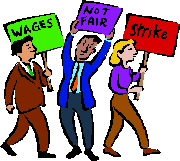By John Wojcik, People's Weekly World
The nations’ biggest labor unions are moving to bring all American unions back together under the umbrella of one national labor federation.
The presidents of 12 of the country’s largest unions called Jan. 7 for reuniting the labor movement, which split into two federations three years ago when seven unions left the AFL-CIO and formed Change to Win, a rival federation.
Participating in the unity meeting were the presidents of five of the Change to Win’s seven unions, six of the 56 AFL-CIO unions and National Education Association President Dennis Van Roeckel. His 3.2 million –member union is the nation’s largest and has always remained outside any larger labor federation.
The leaders made their joint call just two months after unions from both federations celebrated victory with the election of Barack Obama as president. Unions had already set aside their differences and built a united front for the elections.
Besides Van Roekel, in attendance at the meeting were AFL-CIO member union presidents Larry Cohen (Communications Workers), Leo Gerard (Steel Workers), Ron Gettelfinger (Auto Workers), Gerald McEntee (American Federation of State, County and Municipal Employees), Ed Hill (International Brotherhood of Electrical Workers) and Randi Weingarten (Teachers). Change to Win presidents attending were Joe Hansen (United Food and Commercial Workers), James Hoffa (Teamsters), Terry O’Sullivan (Laborers), Bruce Raynor (Unite Here) and Andy Stern (Service Employees). AFL-CIO President John Sweeney and Change to Win Chair Anna Burger were also there.
The Change to Win unions quit the AFL-CIO three years ago, asserting that the federation was not doing enough in the area of union organizing. Since that time, however, both federations have drawn closer together with both focusing on organizing and electoral work.
Leaders of several Change to Win unions have been saying for months now that they see little advantage in maintaining a separate labor federation.
The call for reunification came also after clear signals from President-elect Obama that labor’s interests would be best served in the coming period if there was a united movement.
David Bonior, a member of Obama’s transition team, helped arrange and participated in the reunification meeting that took place Jan. 7.
Dennis Gannon, president of the Chicago Federation of Labor, said Jan. 8, “This news is welcomed by local labor movements and stands to benefit all working people in this country. With a united labor movement, we will be in a better position to make real differences for working families across this great country.”
Many of the presidents of the unions involved reportedly expect, by April 15, to give the OK to a plan to reunify.
Some union leaders are saying, however, that its not a “done deal” and that the possibility of failure to reach an agreement remains.
Some union leaders have raised the possibility that instead of the Change to Win unions simply returning to the AFL-CIO, an entirely new organization might be launched.
The statement by the 12 union presidents at the unity meeting said: “The goal of the meeting is to create a unified labor movement that can speak and act nationally on the critical issues facing working Americans. While we represent the largest labor unions, we recognize that unity requires broad participation.”
Randi Weingarten, president of the American Federation of Teachers, is one of the leaders who attended and supports reunification. “There was a real sense of commitment to unifying our movement again,” she told the press. “It was clear that many of us felt that the whole is greater than the parts, and we really want to do things to help American workers get their rightful place in society.”
Many in the labor movement feel that there is a special need to push hard for unity at this time. With the nation facing its worse economic crisis since the Great Depression, they say, and with the election of a pro-labor president and Congress, the times call for labor to focus like a laser on solving the problems workers face. Passage of the Employee Free Choice Act, seen as critical to growing the labor movement, will not be possible, they say, without unprecedented unity in the ranks of labor. With that unity, they add, it will be possible to convince broad sectors outside the labor movement how critical growing union membership is to fixing the overall economy. That fix, according to labor, is a large number of workers able to spend a growing income on the goods and services produced.
From the Labor Commission of the CPUSA, updates, information, news, analysis, and organizing materials in solidarity with workers of the world.
Tuesday, January 13, 2009
Subscribe to:
Post Comments (Atom)


No comments:
Post a Comment